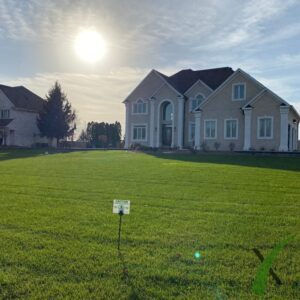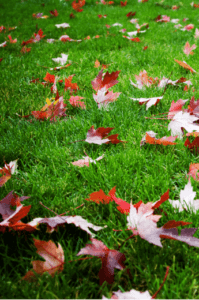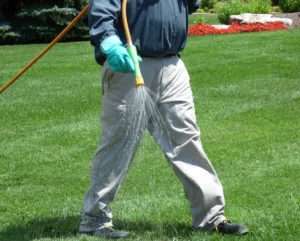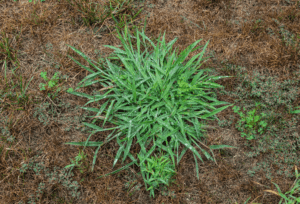A healthy, green lawn takes more than simply watering and mowing; you also need to protect it from unwanted guests. Lawn pests can turn thick turf into patchy, brown messes in a matter of weeks.
Left unchecked, they can damage root systems, invite disease, and make your outdoor space less enjoyable for your family. That’s where professional lawn pest control comes in.
At ExperiGreen, we’ve helped homeowners keep creepy crawlies at bay and keep their yards looking vibrant. In this helpful guide, we’ll break down how pest control works, the most common culprits in Midwest lawns, signs to watch for, and the most effective prevention and treatment strategies.
Understanding Common Types of Lawn Pests in the Midwest
From beetles to biting insects, the Midwest has no shortage of lawn pests ready to feast on grass and gardens. Knowing what you’re up against is the first step in effective pest control.
Here are some of the most common offenders:
- White Grubs: These beetle larvae feed on grass roots, causing dead patches that peel back like a carpet.
- Spiders: While many are harmless and even helpful, some species can bite and may thrive in thick lawns or shrubs.
- Armyworms: These caterpillars feed in large groups, stripping blades of grass almost overnight.
- Chinch Bugs: Tiny but destructive, they suck sap from grass, leaving behind yellowed, drought-like damage.
- Sod Webworms: The larvae of lawn moths that chew grass blades and create silken tunnels in the thatch.
- Billbugs: Weevils whose larvae feed on stems and crowns, often mistaken for drought damage.
- Ticks: Known carriers of diseases like Lyme disease, ticks often hide in tall grass and shady areas.
- Fleas: These biting pests can hitch a ride on pets and quickly spread through your yard.
- Ants: Some species build mounds that damage turf and make lawn activities less comfortable.
Each pest has its own life cycle and peak activity season, which is why a year-round lawn pest treatment plan works best.
Signs Your Lawn Has a Pest Infestation
The earlier you spot pest damage, the easier it is to treat, and the less costly it will be to repair your lawn. If you notice any of these common symptoms, it’s time to take action before the damage spreads.
Keep an eye out for these telltale signs:
- Brown patches that expand quickly despite regular watering
- Wilting grass in irregular patterns
- Thinning turf that feels spongy underfoot
- Visible insects or larvae when inspecting soil and thatch
- Animal activity, like birds, raccoons, or skunks, digging for grubs
- Chewed blades of grass or missing leaf tissue
- Mounds, tunnels, or webbing in turf or flower beds

Treatment Strategies for Lawn Pests
The best lawn pest control for your lawn depends on the type of pest, the severity of the infestation, and your long-term lawn care goals. While some problems can be handled with natural solutions, others require targeted treatments for lasting results.
Chemical Methods
When pest populations get out of hand, chemical treatments can quickly bring them under control. These products are designed to target specific pests while minimizing harm to beneficial insects when applied correctly.
Examples of chemical treatments include:
- Insecticides: Granular or liquid applications that treat lawn surfaces and soil layers.
- Targeted Grub Control: Preventive and curative treatments that stop grubs before they destroy roots.
- Surface Feeding Insect Control: A specialized service to eliminate pests that damage turf blades and crowns.
Integrated Pest Management (IPM)
IPM combines multiple control methods to reduce pest problems over time while protecting the environment. This approach focuses on prevention first, then uses targeted treatments only when necessary.
Key steps in IPM include:
- Monitoring: Regular inspections to detect pest activity early.
- Identification: Correctly diagnosing the pest to choose the right treatment.
- Prevention: Adjusting lawn care practices to make your yard less pest-friendly.
- Treatment: Using the least-toxic, most effective treatment method available.
- Evaluation: Reviewing results and adjusting strategies for future prevention.
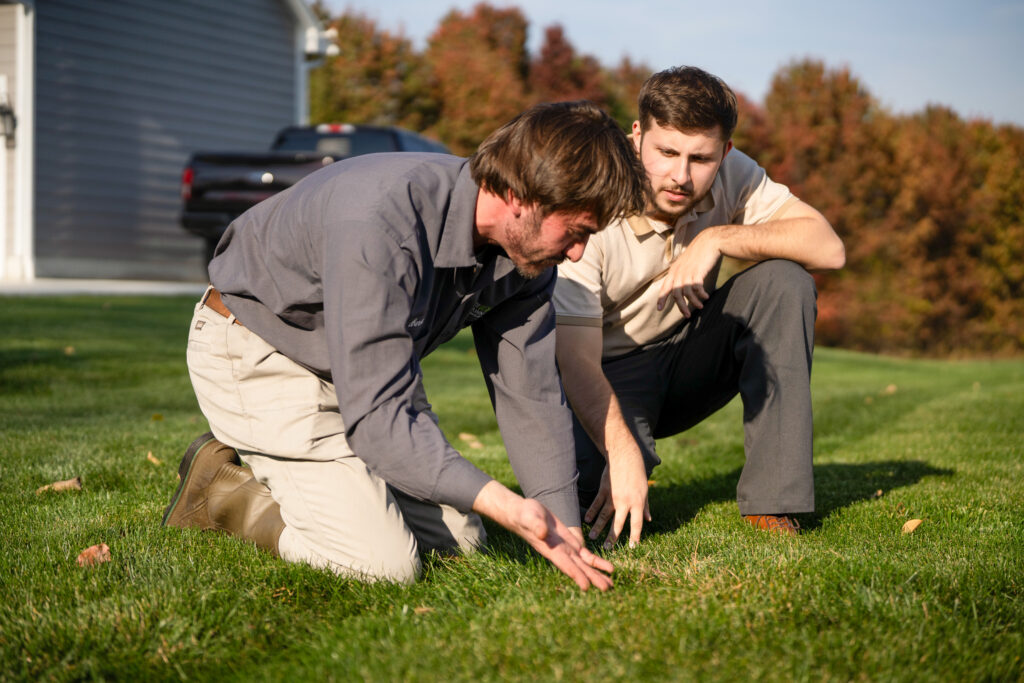
How Professional Lawn Pest Control Works
While DIY pest control can be effective for small problems, professional services offer the expertise and resources to fully protect your lawn. Here’s what you can expect when you choose a company like ExperiGreen:
- Inspection & Identification: A lawn care specialist will inspect your yard, identify pest issues, and evaluate overall turf health.
- Custom Treatment Plan: Based on the type of pest and severity of the infestation, a tailored plan is created for your lawn’s needs.
- Targeted Applications: Treatments are applied at the right time in the pest’s life cycle for maximum impact.
- Follow-Up Visits: Our technicians return as needed to monitor results and apply additional treatments if necessary.
- Preventative Recommendations: We provide guidance on mowing, watering, and seasonal maintenance to keep pests from returning.
Our lawn pest control services often include specialized programs like perimeter pest control to stop pests before they enter your home, making them a smart investment for both lawn and household protection.
DIY vs Professional Lawn Pest Control
Some homeowners prefer to tackle pest problems themselves, while others rely on professional help. Both approaches have pros and cons, but the right choice depends on your lawn’s needs, your available time, and your comfort level with pest control products.
DIY Lawn Pest Control
While at-home remedies may have lower upfront costs, they’re often not as effective as professional services. Small mistakes can also lead to serious grass damage.
Our team knows how to quickly identify the type of pest infesting your lawn and create a custom treatment plan to evict them.
Professional Lawn Pest Control
When you work with a professional lawn pest treatment company, you get expert pest identification, tailored treatment plans, and access to professional-grade products.
For many, professional services provide peace of mind and a healthier lawn year-round, especially when pests like grubs, chinch bugs, or ticks are involved.
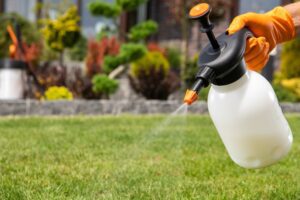
Prevention Tips to Keep Pests Out of Your Lawn
The best way to handle pests is to prevent them from making themselves at home in the first place. Healthy, well-maintained lawns are naturally more resistant to infestations.
To keep your lawn healthy and lush, you can:
- Mow regularly at the right height to discourage pests from hiding in tall grass.
- Water deeply but infrequently to promote strong root growth and avoid overly damp soil that attracts insects.
- Invest in professional lawn aeration to improve soil oxygen and nutrient flow, reducing stress on turf.
- Schedule a soil health test to ensure your lawn is getting the nutrients it needs to stay strong.
- Keep up with seasonal pest inspections from a professional to catch problems early.
- Try a routine mosquito control program to protect your outdoor spaces from biting pests that thrive in standing water.
Get Professional Pest Control with ExperiGreen
Lawn pest control requires attention to detail and extensive knowledge of local climates. From knowing which pests to watch for to using the right treatments at the right time, a strategic approach keeps your lawn healthy year-round.
Whether you handle small issues yourself or partner with a professional team, consistent care is the key. With ExperiGreen, you get proven pest control programs tailored to Midwest lawns, so you can enjoy a greener, healthier yard without the guesswork.
Give us a call today or visit our website to book the next pest control service in your yard.
Frequently Asked Questions
When should I apply pest control on my lawn?
The best timing depends on the type of pest. For grubs, apply treatments in late summer when they’re young and actively feeding. For surface pests like chinch bugs, treat as soon as activity is noticed. Many homeowners opt for seasonal treatments to cover the most active pest periods.
How often should you get pest control done?
With ExperiGreen’s lawn pest control programs, treatments are applied several times a year to break pest life cycles and maintain protection. The frequency of the treatments depends on the severity of the infestation and your lawn’s current condition.
How do I know if my lawn has grubs?
Dead patches that peel back easily, increased animal digging, and visible white larvae under the turf are key signs. If you notice these symptoms, ExperiGreen’s grub control service can stop the damage before it spreads.
What if it rains after applying pest control?
Light rain can actually help certain treatments soak into the soil. Heavy rain, however, may wash products away. If significant rainfall occurs shortly after treatment, contact your provider to determine if reapplication is needed.


